
Fair Trade Coffee. Certified Humane Raised and Handled Chicken. Organic everything.
Anyone not living under a rock in a remote, sandy location for the last five years has seen the prodigious rise to prominence of eco-labels at their local grocery store. You may not pay these little badges much attention, or if you do, you may be wondering what the heck they mean.
Read them or not, the badges of virtue on everything from cereal to chicken to laundry detergent are bound to get more prevalent, and represent an attempt by many companies to find a niche in an ever-expanding food and food products market. Join me for a stroll down the aisles as we try to decipher what these insistent insignias truly stand for.
Let’s start with an easy one (please note the sarcasm, as it is surely merited) after the jump:
USDA Organic
The National Organic Program (NOP) has a fairly long (relatively speaking) and sordid history, of which you’re welcome to read about in the NOP’s Reading Room on their website. I’ll try and be brief here, and stick to the important stuff.
There are no less than four ways that you can buy a product that has been certified organic (and I bet you thought there was only one!).
- “100 Percent Organic” – Everything in the packaged product, or a single ingredient product, has to be certified organic, even the “processing aids”. It’s interesting that the labeling requirements for 95% organic products and 100% organic products are the same, except the 100% products can say “100% organic”. You’ll see the seal on these products.
- “Organic” – Basically the same as above, except 5% of the product (by weight) can be nonorganic ingredients not commercially available in organic form. Same label, probably the same street cred. Oh, and for you wine drinkers, no additional sulfites (there are some sulfites produced by fermentation) can be added. The USDA seal can be slapped on these products as well.
- “Made with Organic Ingredients” – has to contain at least 70% organic ingredients, no sulfites allowed unless it’s sulfur dioxide in wine (wine drinkers, pay attention here, they can use diatomaceous earth as a filtering aid. That is, diatoms in your wine.) according to 7 CFR 205.605 – great bedside reading by the way. Important note here: you can’t use the USDA seal on your product. Ever.
- “This product has some organic ingredients” (really) – contains less than 70% organic ingredients, and if you name which ones are organic on the ingredients list, you can claim it on the package. No USDA seal on these products either.
Want to make a quick buck and slap an organic seal on your nonorganic cereal or bottle of juice? There’s a hefty civil penalty of up to $11,000 for messing with that seal, so you can take it on pretty good authority that most products with the seal are telling the truth.
Clear? Good. Let’s try a couple more:
Certified Humane
Certified Humane Raised and Handled is a certification and labeling program that is the only animal welfare label requiring the humane treatment of farm animals from birth through slaughter.
Certified Humane Raised and Handled Means:
- Animals have ample space, shelter and gentle handling to limit stress. Does food that experiences less stress taste better? Why not find out?
- Animals have access to ample fresh water and a healthy diet of quality feed, without added antibiotics or hormones. I know, I know – getting free antibiotics from your chicken seems like a heckuva deal, but subtherapeutic antibiotics may not be good for the health of the animals or people.
- Cages, crates and tie stalls are among the forbidden practices, and animals must be free to do what comes naturally. For example, chickens are ale to flap their wings and dust bathe, and pigs have the space to move around and root. This is a really progressive concept – allowing animals to behave like…animals. Brilliant! I don’t know about you, but I like my chicken to taste like chicken. What better way to do it than to let the chicken act like one!
These are general descriptions of their standards. For more information, you can view the standards for each species of livestock online, after providing some registration information. Or, you can take a look at the standards as compared to other humane labeling standards. The certified humane raised and handled standards are based on the Royal Society for the Prevention of Cruelty to Animals standards, as well as scientific research, veterinary advice, and the experience of farmers. The standards committees are made up of university professors and members of other non-profit organizations like the ASPCA.
Of note, the standards stipulate that mammals are not fed any mammalian or avian protein by-products (i.e., feeding cattle to cattle) aside from milk or milk products like whey, a common feed for hogs. This is good if, say, you don’t want to risk getting a prion disease like Bovine Spongiform Encephalopathy (mad cow disease). For broiler chickens, they are not permitted to be housed in cages or live on slatted or wire floors, reducing stress on the animal.
The standards also include rules for slaughter and packing which take into account the animal’s biology and comfort levels to reduce stress. So, if you want to know that your meat has been raised on a wholesome diet, led a relatively low-stress life, and allowed to act like its biological self, Certified Humane Raised and Handled might be the way to go.
Fair Trade Certified
Transfair, the certifying agency, claims to be the only independent, third-party fair trade certifier in the U.S., and is a member of Fairtrade Labelling (sic) Organizations International (FLO). The organization started certifying with coffee in 1998, and has branched out to tea and herbs, cocoa and chocolate, fresh fruit, sugar, rice, vanilla, flowers and honey.
Fair Trade principles include:
- Fair prices: Organized farmer groups get a guaranteed price for their goods, and are also eligible for credits pre-harvest. Imagine that – paying a fair price for goods so that farmers can count on being able to put food on the table after they spent all day harvesting food for someone else.
- Fair labor conditions: Workers on Fair Trade farms enjoy freedom of association, safe working conditions, and living wages. Forced child labor is strictly prohibited. A living wage. What a novel idea!
- Direct trade: Importers purchase from Fair Trade producer groups as directly as possible, eliminating unnecessary middlemen and empowering farmers to strengthen their organizations and become competitive players in the global economy. Given that the middleman is cut out, this allows you to get more of a direct line on where your food comes from. Neat.
- Democratic and transparent organizations: Fair Trade farmers and farm workers decide democratically how to use their Fair Trade premiums. A democracy that acts like one!
- Community development: Fair Trade farmers and farm workers invest Fair Trade premiums in social and business development projects like health care, new schools, quality improvement trainings, and organic certification. Stronger communities may help to build better, more responsible farms and farmers in rural areas that have few other sources of revenue. Sounds good.
- Environmental sustainability: The Fair Trade certification system strictly prohibits the use of genetically modified organisms (GMOs), promotes integrated farm management systems that improve soil fertility, and limits the use of harmful agrochemicals in favor of environmentally sustainable farming methods that protect farmers’ health and preserve valuable ecosystems for future generations. If green is the new black, then sustainability is the new green.
Fair Trade gets their standards from FLO, which develops their rules using the input of producers, workers, mission-based companies, conventional traders, labeling initiatives (like TransFair USA), and independent consultants specializing in Fair Trade and labor issues. You can learn more about the specifics at www.fairtrade.net.
Food Alliance Certified
Food Alliance is: a sustainability certification which started as a project between Oregon State University, Washington State University and the Washington State Department of Agriculture. The group now includes farmers, scientists, food processors and distributors, environmentalists, and even consumers, that work to certify fruit, vegetable, and livestock farms in a way that uses market-based strategies to affect change in the market.
Food Alliance certification involves a “whole farm” approach to certification, and the standards they use vary depending on the farm and their products. Food Alliance uses a third-party organization, International Certification Services, to inspect the sites that they certify.
Food alliance certification involves animal welfare, genetically-modified crops (GMOs), pesticide use, hormones and antibiotics, water conservation, habitat conservation, and other areas of resource use and production at the facilities. Food Alliance aims to expand their certification and client base in a way that changes the market, making sustainable farming and their certification a desirable goal for farmers and producers.
Hey, what about Rainforest Alliance Certified, Demeter, Marine Stewardship, or some of the other labels I see in the aisles?
There’s definitely more where these labels came from; Oregon Tilth Certified Organic, Salmon Safe, and others. But all of this labeling can be a bit overwhelming, especially all at once. In a recent National Geographic article on the problem of soil management in Africa, an interesting acronym was used, MEGO (My Eyes Glaze Over). Since MEGO can happen quickly when talking about these eco-labels, I’ll end here.
If you’re hungry for more, or there’s a badge on your cereal, hand lotion, or bottle of wine that you’d like to know more about, check out the Greener Choices Eco-labels Center at greenerchoices.org. It’s a good resource with some helpful report card-style information on a number of labels. And remember, when you’re shopping, make sure you’re also thinking.
Image credit: lyzadanger at Flickr under a Creative Commons license


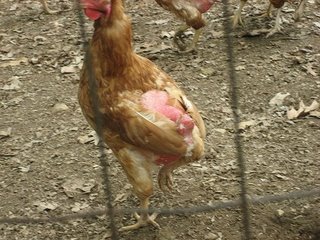
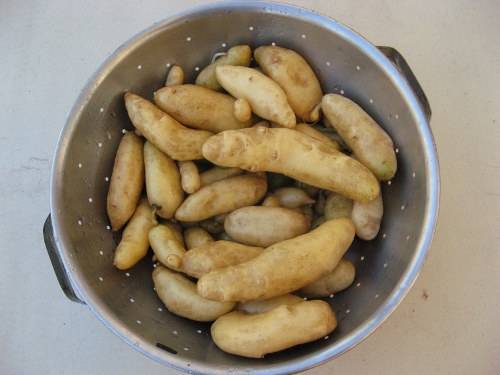

![Food & Climate Change [VIDEO]](https://eatdrinkbetter.com/wp-content/uploads/2010/07/climate-change-agriculture.jpg)
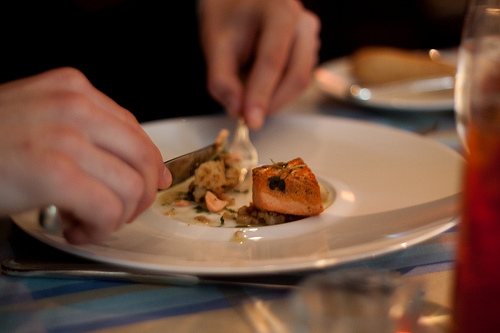
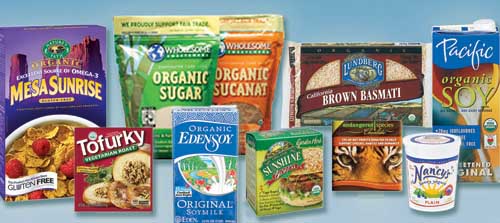
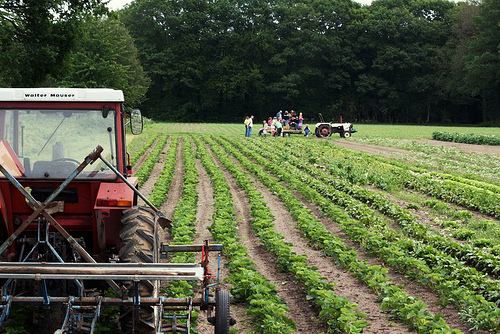
I like Animal Welfare Approved better than Certified Humane because it actually requires outdoor, pasture access. I also like the new American Grassfed Association program that certifies 100% grassfed ruminants. Although there is no certification yet for non-ruminants that need some grain, look for the words “pasture-raised” for chickens and pigs.
Rebecca,
Those are great tips, and thanks for mentioning those other certifiers. My goal with this article was to cherry-pick a few examples of the multitude of labels and certifications out there on the market. You’ve hit on two really good ones. Grassfed livestock is a much lower-impact way to farm, and it produces meat that has a better nutritional profile than some of the commodity livestock. Pasture-raised is a good thing, but defining the “pasture” is where it gets tricky. Though, if you know the farmer who raised your chicken, it’s a no-brainer.
Thanks for writing about food labels Bryan! You indicated that it’s difficult to know whether or not the animals are grazing on quality pasture on certain farms. It’s important that your readers know that Animal Welfare Approved ensures that the farms we approve provide the animals with pasture that includes a rich variety of vegetation and green plants. Our auditing team only approves farms that provide their animals with excellent pasture and we also require a formal pasture management plan for each farm in order for them to maintain the highest pasture quality. For consumers looking for farmers that raise their animals according to the highest welfare standards on high quality pasture they should look for the Animal Welfare Approved label. http://www.AnimalWelfareApproved.org
Was a great education .
Thanks,
Thanks Mimi! I loved writing this piece.